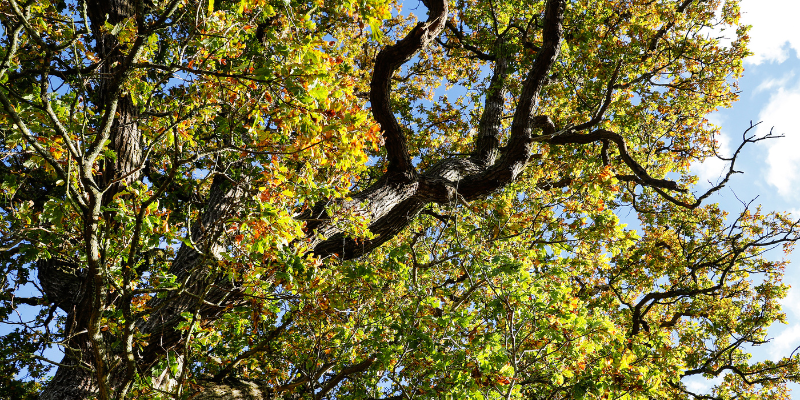
Veteran and ancient trees - what’s the difference?
Ancient and veteran trees provide a whole host of benefits to the environment and to people. The longer a tree has stood in one spot, the more it will be entwined with the lives and culture of local communities.
What's the difference between ancient and veteran trees?
Ancient trees are those which have outlived the typical lifespan of their species and display features of this exceptionally long life. These features vary from tree to tree due to the number of environmental factors that affect each individual tree's growth and survival.
For example, this horse chestnut (Aesculus hippocastanum) below boasts an impressively large trunk, with the remaining side branches giving just a hint of the size of the crown in the past. The trunk, whilst wide, is hollow and stops abruptly where the old stem and crown died or snapped, but the tree remains alive and well.
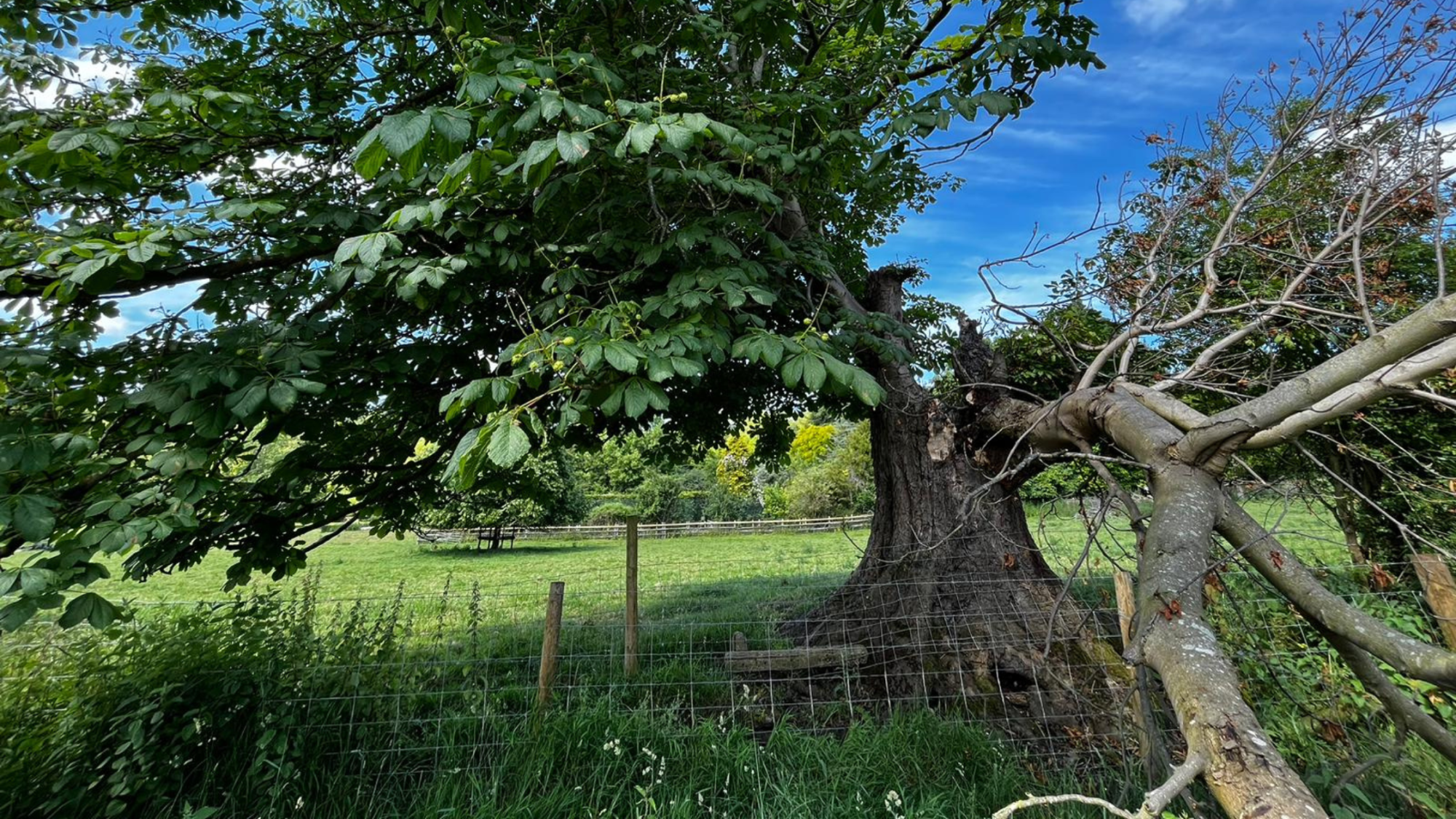
On the other hand, whilst the tangles and twists of this hawthorn (Crataegus monogyna) below are less imposing than the horse chestnut, they are no less ancient. This tree's horizontal form indicates that it was once laid, presumably as part of an old hedgerow. (More on hedgerow laying here). It too has signs of decay and hollowing in the stems, and it too continues to grow happily.
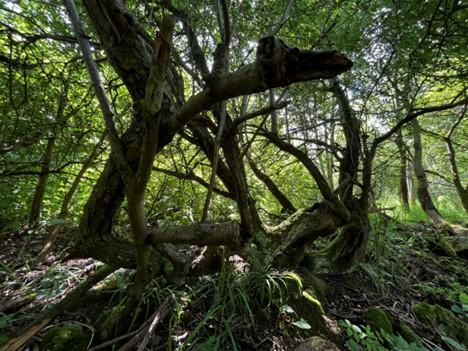
The result of a long life is often a few battle scars - old wounds from limbs being torn off in storms, internal decay and holes in the trunk - which are known as 'veteran features'. Whilst ancient trees often display a lot of veteran features, not all trees that exhibit these traits are ancient.
The bay willow (Salix pentandra) below has a lot of veteran features. Willows often grow in a multi-stem habit, sending up multiple shoots instead of one main trunk. As the tree grows, the added weight and sail volume of each stem exerts more force on the base where all the stems join, sometimes causing it to split, as seen here. This split can be an entry point for disease or decay, which can in turn widen the split, worsening both the structural problems and risk of infection.
However, trees can heal these wounds, either by sealing them entirely or by forming internal barriers to compartmentalise the site of decay (Shigo 1984). This is exactly what has happened here. The tree has split and decayed, but it has reacted to this by compartmentalising the decay and preserving healthy wood that keeps it alive and growing. Higher in the crown there is a tear out wound from where a stem has failed and snapped off, exposing the heartwood and tearing down the sapwood and bark. Veteran features like these can arise from all sorts of pressures, like weather, surroundings, animals and people.
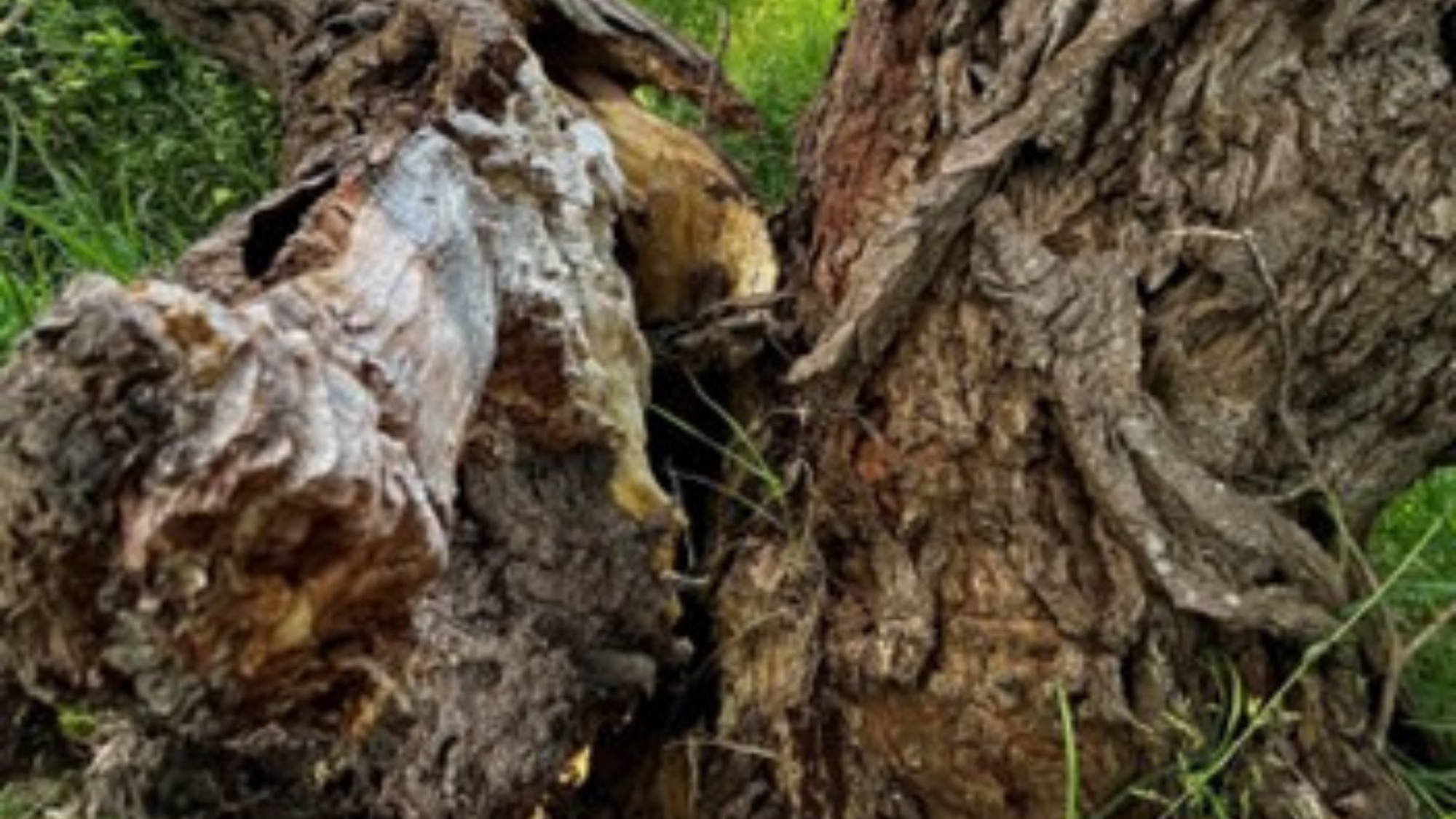
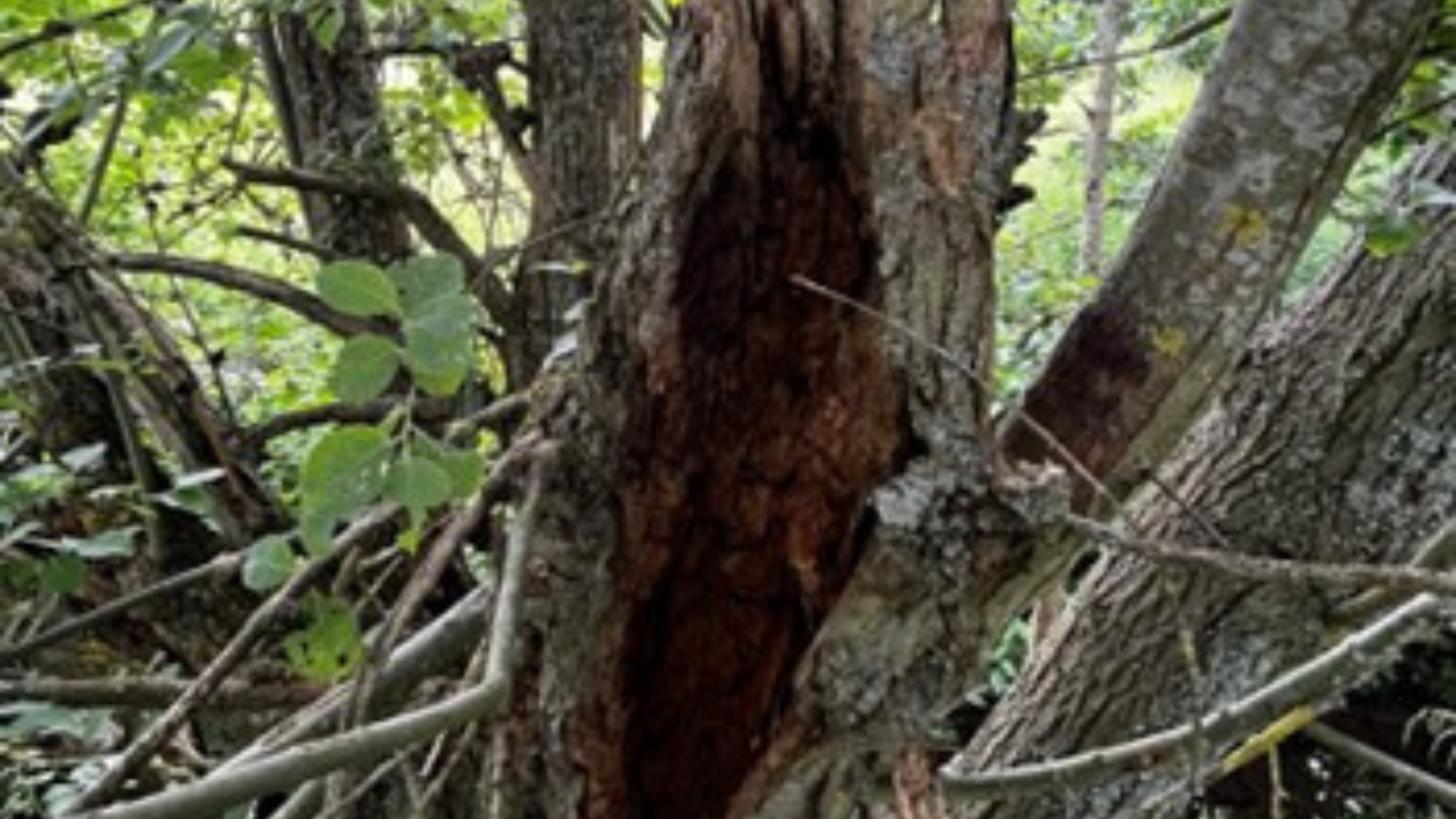
How do these trees stay standing?
When trees are growing, they respond to many different stimuli. Two of these responses are phototropism (where plants grow towards a source of light - this is the reason trees at the edges of woodlands can seem to 'lean out') and geotropism (where plants grow away from gravity, keeping them upright). Another is known as the 'axiom of uniform stress', where the tree responds to the weight distribution of its crown by growing 'reaction wood' in areas where more support is needed, keeping the stress the same all the way around the trunk. Cavities caused by decay, branches torn off by wind, and splitting stems all upset the balance the tree is trying to maintain.
Thankfully, trees are strong and can often survive these afflictions by reacting to them. Losing a branch from the north side of the crown would shift the overall weight to the south side, causing more stress to that side of the trunk. The tree compensates for this shift by building wood with compressive strength on the south side of the trunk and tensile strength on the north side. If the injury to the tree is not too great, or if it occurs gradually, the tree is most often able to withstand it.
A tree’s vascular tissue lies between the bark and the heartwood and is crucial to the survival of the plant. If a tree’s vascular tissue is compromised all the way around its circumference, the tree will most likely die, at best regrowing from below the damaged area. However, if even one bit of cambium remains intact and functional, water and nutrients can still be transported around the plant. This can lead to some trees surviving against the odds, such as the veteran elm below.

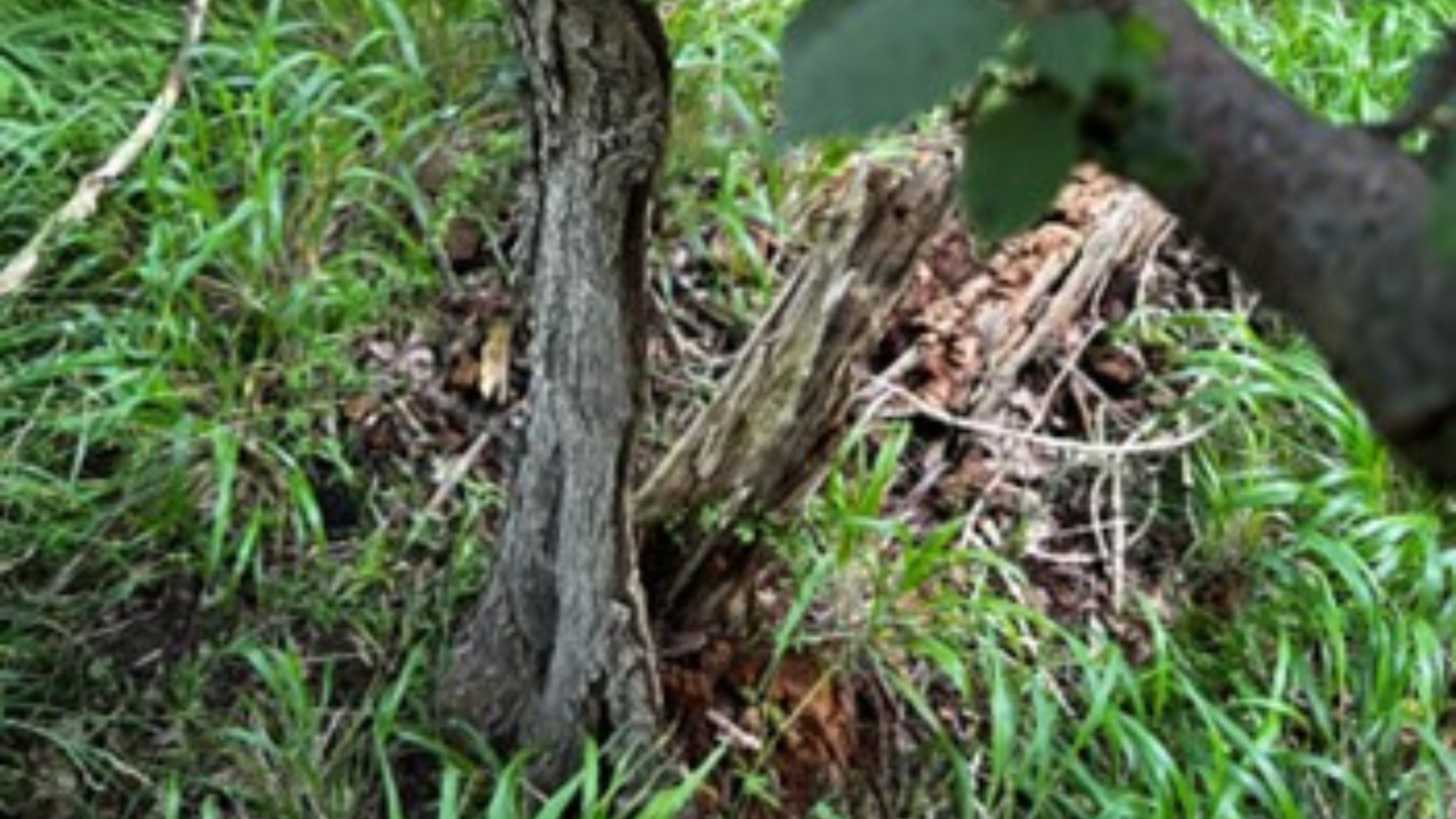
The value and importance of ancient and veteran trees
Preserving both ancient and veteran trees has massive ecological and environmental benefits. Veteran features are often repurposed by wildlife as roosting and nesting sites, especially by birds, bats and bees (see photo below), and the decayed wood that abounds in ancient and veteran trees is important for saproxylic insects. This is a class of invertebrates that depend on decaying wood, either using it as a habitat or as a food source, most often in their larval stage - in fact, the larvae of the stag beetle (Lucanus cervus) are saproxylic.
By retaining these old and gnarled trees, we can improve the connectivity of habitats across our forests. Each tree that provides these environmental services can be thought of as a node in a network, and the more nodes there are, the more options there are for specialist species to migrate, breed, and spread across the country.
You may have heard of 'mother trees' (Simard 2021), trees which provide shelter and nutrients to other trees in their area, not necessarily of the same species. This exchange is helped by mycorrhizal fungi, which interface with the tree roots and provide a pathway for nutrients and chemical signals. The longer the tree has been established, the more developed its root system and mycorrhizal connections will be, and the more able it will be to 'nurse' other trees (Sverdrup-Thygeson et al 2017). The deadwood generated by ancient and veteran trees also cycles these nutrients back into the soil, improving the soil microbiome and health of the ecosystem.
On top of this, the veteran features (as already discussed) are hotspots for biodiversity and specialist species, adding to the diversity of the fauna in a woodland, which goes hand-in-hand with the diversity of the flora. A complete and diverse ecosystem is more able to withstand pests, diseases, and tough environmental conditions. Conserving and caring for ancient and veteran trees is therefore essential not only for the survival of our ancient woodlands, but also for the development and improvement of our establishing woodlands.
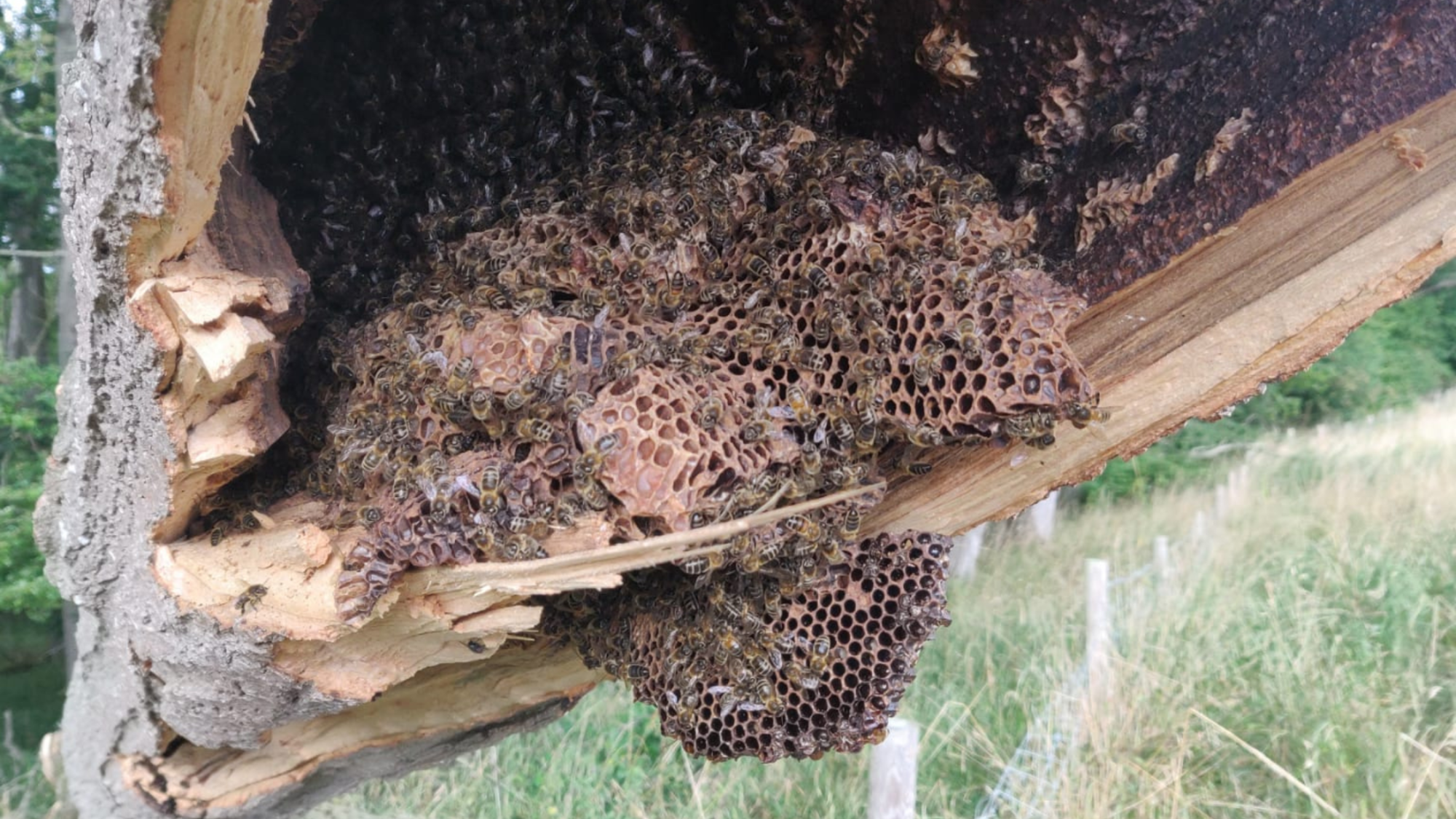
Managing ancient and veteran trees
Veteran features can have implications for safety in high-confluence areas. A tree that is struggling to adapt to structural imbalance, or one that is on the verge of shedding a large limb due to decay, could fail unpredictably, causing damage to anything or anyone that it hits on the way down. However, in less-frequented areas, these risks can be balanced by the biodiversity, habitat, and aesthetic improvement they bring.
At the Heart of England Forest, our management of veteran trees is typically minimal, often taking the form of not cutting deadwood from the crown, leaving standing deadwood where possible, and not interfering with cavities or holes. It also means protecting the lower parts of the tree by minimising contact with people and livestock and leaving the surrounding ground unploughed and uncleared to preserve and nourish the tree's root system.
In urban areas, or places with lots of public access, it can be tempting to manage ancient and veteran trees by cutting out all deadwood or treating wounds and stumps. However, heavy-handed interference can further upset the balance of the tree and potentially expedite a failure, for example by redistributing the crown weight too drastically, or by leaving numerous wounds. It is therefore essential to carefully inspect the tree before deciding on how to manage any potential hazards, and to consider the stresses acting on the tree and their consequences.
Veteran trees are often some of the most interesting trees in woodlands and have implicit aesthetic value. By keeping them around in both forested and urban areas, we can make the outdoors an even nicer place for people to be. It is our duty as responsible foresters and forest visitors to protect and care for these trees by letting them react and respond to the natural environment in their own way, in their own time.
Become a friend of ancient and veteran trees
Ancient and veteran trees provide a whole host of benefits to the environment, wildlife, and to people.
At only 13%, Britain has one of the lowest percentages of tree cover in Europe. This has taken a terrible toll on the environment, people, and wildlife. By donating £5 a month, or more if you can, we will keep you up to date with the latest news from the Forest, and how you are helping ancient and veteran trees as well as new plantations thrive.
References
-
Jarman, R., Moir, A. K., Webb, J., Chambers, F. M., Russell, K. (2018) “Dendrochronological assessment of British veteran sweet chestnut (Castanea sativa) trees: Successful cross-matching, and cross-dating with British and French oak (Quercus) chronologies”. Dendrochronologia. 51:10-21.
-
Shigo, A. L. (1984) "Compartmentalization: A Conceptual Framework for Understanding How Trees Grow and Defend Themselves". Annual Review of Phytopathology. 22 (1): 189–214.
-
Simard, S. 2021. Finding The Mother Tree. Penguin.
-
Sverdrup-Thygeson, A., Skarpaas, O., Blumentrath, S., Birkemoe, T., Evju, M. (2017) “Habitat connectivity affects specialist species richness more than generalists in veteran trees”. Forest Ecology and Management. 403: 96-102



